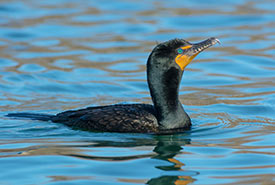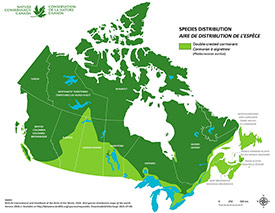
Double-crested cormorant (Photo by Paul Reeves, CC BY-NC-SA 4.0)
Double-crested cormorant
Double-crested cormorants are relatively large water birds. This species of cormorant is the most widespread in North America. Though they are now common, double-crested cormorants were once at risk. Currently, this species occurs in many different Nature Conservancy of Canada (NCC) properties from coast to coast.
What does the double-crested cormorant look like?
Double-crested cormorants are similar in size to a small goose, around 80 centimetres tall, and with a wingspan of 120 centimetres. As with all cormorants, double-crested cormorants have long necks and black feathers. They can be confused with common loons, but they have a striking, hooked bill and tend to sit a little lower in the water. Adults in the breeding season have a small patch of orange-yellow skin on the face. Before maturing to their adult, black-feathered form, double-crested cormorants have grey-brown feathers all over.
Where does the double-crested cormorant live?
Double-crested cormorants are currently widespread across much of southern Canada. During the breeding season they can be seen near water in many major cities. The largest populations are seen throughout the central United States, Alberta, Saskatchewan and Manitoba. This species nests in colonies and feeds in lakes and along coasts. Birds that breed in Canada migrate to marine coasts along the U.S. and Mexico, and inland lakes in the southeastern U.S. for the winter.
What is the double-crested cormorant's conservation status?
As of 1978, the Committee on the Status of the Endangered Wildlife in Canada assessed double-crested cormorants as not at risk due to substantial population increases. Prior to 1978, double-crested cormorants experienced a significant decrease in population due to susceptibility to DDT, a common pesticide at the time, which proved to be toxic toward many bird species at the top of the food chain. As an upper trophic-level predator in aquatic systems, cormorants are useful indicators of environmental pollution and may contribute to limiting invasive prey populations. Historically, nesting colonies of double-crested cormorants were also persecuted in many parts of their range. Human persecution of double-crested cormorant colonies (and other waterbirds, including American white pelicans), up to the early 1900s, severely reduced their numbers throughout North America. This was primarily because they were seen as competition for commercial fish.
Its populations have rebounded and continue to expand. In some areas large, rapidly recovering nesting colonies threaten other waterbirds and can degrade the habitat of species at risk which now occur in very limited areas.
What is NCC doing to protect the double-crested cormorant's habitat?
Double-crested cormorants have found habitat in NCC protected properties across the country. Governor’s Island near Charlottetown provides habitat to many species, including thousands of double-crested cormorants. In New Brunswick, double-crested cormorants also nest on NCC’s Tern Island property. The Mahone Islands Conservation Association in Nova Scotia works with NCC to provide habitat for dozens of species of birds, only one of which is the double-crested cormorant. Across the country, NCC’s Swishwash Island property was the subject of an eight-month study by students at the British Columbia Institute of Technology, who observed double-crested cormorants, short-eared owls and other bird species.





